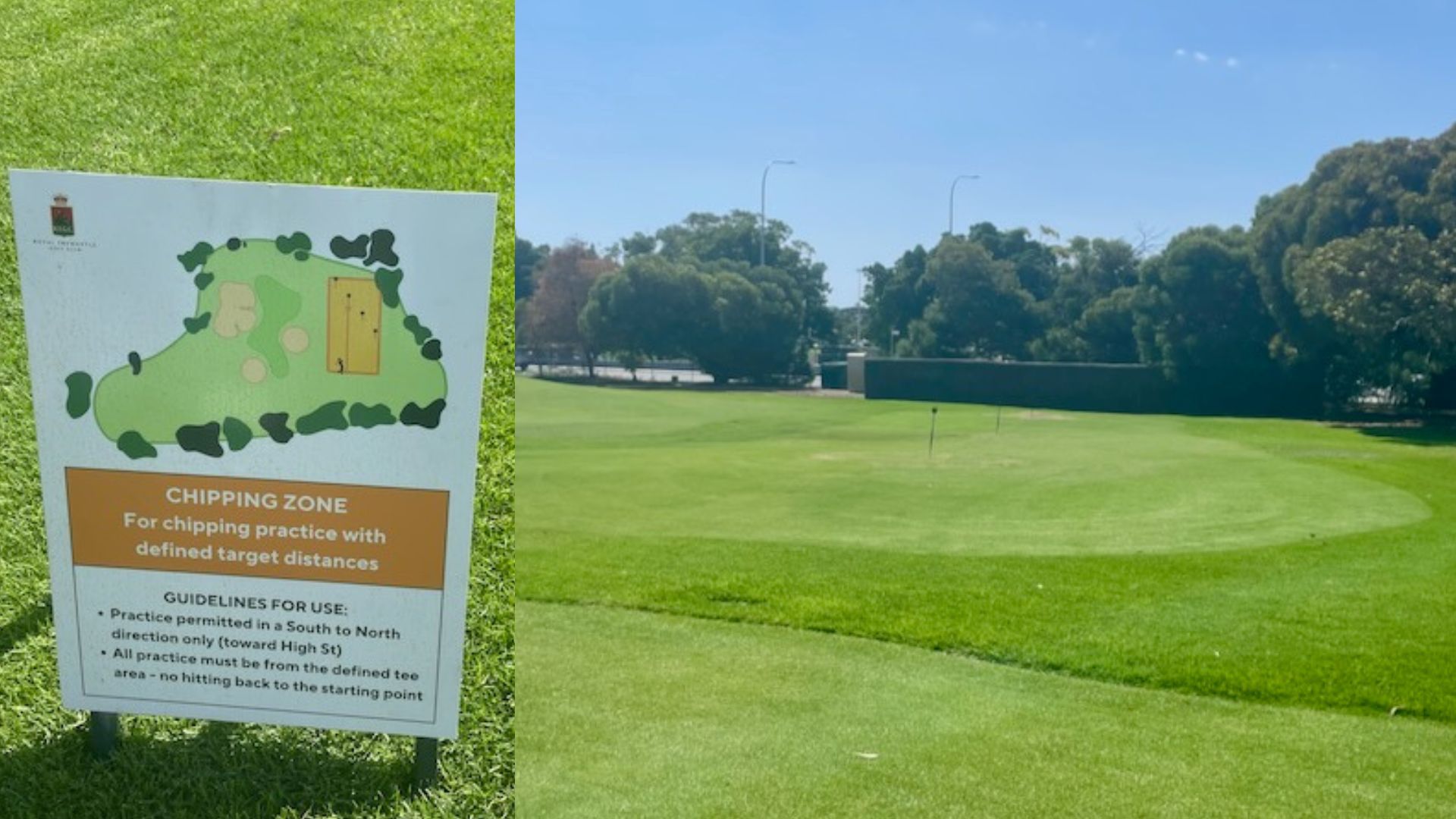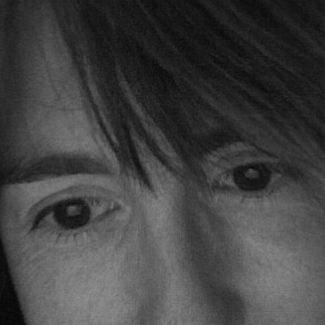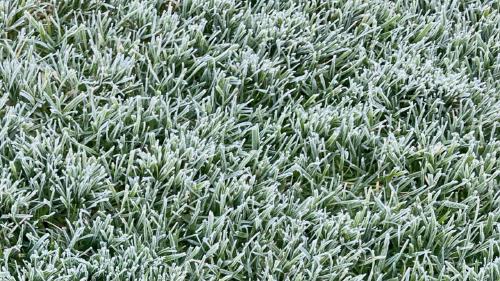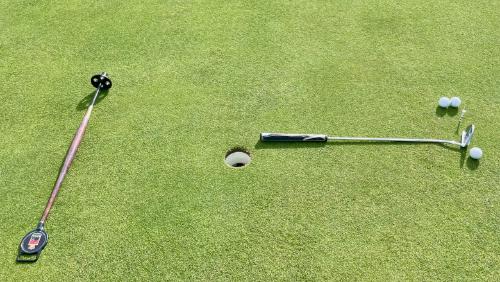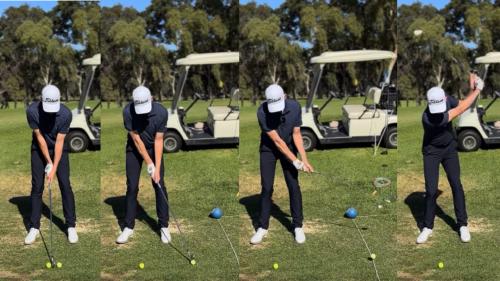Regular practice, for 5 days out of 6 after my first, meant my second golf lesson was about the follow through, along with tips for practice and analysis of progress…
…the latter designed to keep me positive, while helping me to improve.
The image above is the chipping zone where I practice most of the time, with three landing areas and markers at different distances. I’m also using the area where I can chip and pitch up to the green (with a variety of flags set up), because that looks and feels more like the course itself. The practice area is excellent (so long as it’s not too busy, since not everyone obeys the rules):
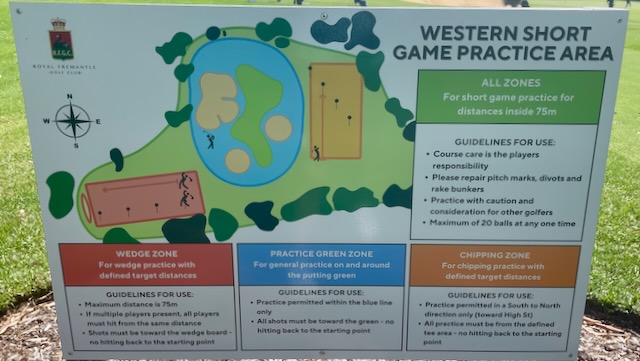
My second lesson allowed me to check how well I’d implemented my new process, from looking and thinking, through setup and into the shot itself.
It can easily go wrong:
The most important things I’ve been noticing sometimes as I practice, but mostly when playing a competition round, are:
- Forgetting to stretch up and level myself out (what that means depends on the lie, uphill, downhill etc). The relaxed tension in the spine and balance across the head and shoulders is vital to allowing the shoulders and arms move through the swing rhythmically to make clean contact with the ball
- Introducing too much wrist hinge rather than keeping the hands neutral. A wrist hinge can be added, and I expect it naturally is, as the shot gets longer (just by feel for what I need to do), but it’s not needed on most short shots and is counter productive, either making for too much force and therefore length on the shot, or missed ball contact (chunk and flub or maybe a thin shot)
Although I have chunked a few chips on course, my main miss has been thinning very short shots. I’m not totally sure why this is, but it’s probably to do with too much tension in arms and shoulders, looking up too soon (to see the result), a lack of rhythm in the shot and not feeling comfortable in setup.
All I can do is to stick with the process, accept the anxiety (because a shorter shot is no less anxiety inducing than a longer one) and carry on practising. The new focus on follow through may help with this issue too (see below).
I do think the other thing to remember is that all this work on higher flighted chip shots (56 degree wedge for me) means I’m less comfortable with the low chip and run (8 or 9 iron) that used to be my go-to whenever possible. I can learn to do both these things, but the feel is different and I could do with more practice moving from one to the other. On some lies and flag positions the low chip and run is still easier for me to visualise and execute (with good results).
New process/shot goals:
- Continue to work the process up to and through setup and into the shot
- Now think about providing the required centripetal force to control the follow through. Aim to keep club handle closer to the body and under control with club head in a balanced position, so as not to be pulled out of balance (retaining a balanced feeling is how that weird visual of placing the club in a hip holster after a shot comes about)
- Finish tall, facing the target (ish), gluteal muscles in tension, knees together, all in balance so the arms can relax
Things to watch:
- Allow the right heel to lift as you follow through! Because when I’m aiming for a position with tension in some of my body I can forget to allow other things to move (this particualar one leading to a sore back with too much arch)
Things to try:
If you lose the feel/it feels awful:
- Use right hand only to setup
- Take some right-handed swings (with/without hitting balls)
It’s much easier to setup and to feel when and where things are out of balance at any point with just one hand on the club! This won’t really work with the new follow through focus completely (I think), but it should help get things back on track for more practice.
- Rhythm is everything - imagine it, then do it
Implement PAD analysis:
- P is for Process. How well did you run the process, from looking and thinking to taking the shot? Did you feel ready?
- A is for Accuracy. How close were you to the line you chose for the shot?
- D is for Distance. How well did you control the distance (to the carry point and/or the final resting place, because both matter and your focus might have been one or the other, and your subconcious might have picked one or the other too)?
You can score each of these out of 10, but don’t forget to build a feedback sandwich. There will be some thing(s) you did well, some thing(s) to improve and you need an overall good take on the shot to finish with (since even a chunk/thin could well have been in the right direction, or maybe the shot was awful but the end result was fine).
Thinking about distance control… it might be worth getting a sense of which focus works naturally in different situations. I know I think about both aimpoints for carry and aimpoints for runout at different times on course, but where do each of these things have the best results for me?
What I learnt from my first long practice session
Practice is hard. I started well and then lost concentration. Something similar can happen when you’re playing too. I got hot (and that makes it easy to lose body form and mental focus). Process is important. Visualisation is important. Taking time with setup and then rhythm of movement is important. I managed to get back on track today by resetting myself and laying out out some challenges to help me stop and think over each shot.
- Having rhythm across the swing is absolutely vital
- Being purposeful is vital too (and, for me, that feeling is particularly difficult to achieve the shorter the shot and the less movement is involved)
Revised notes for my coach:
- I can’t see how you’re going to manage not to tell me why I need to do something (which is what I suggested last time)!
Although it would be good to reduce my brain’s cognitive, analytical and critical load in a lesson, I don’t think it’s possible. I just need to take the hit, spend some time on the feels with some practice of my own just after, and then process the lesson later (even a few days later) as I’m doing here.
